2014年辽宁教师考试小学英语说课稿:《PEP5 Unit2 B Let’s talkPair work》说课稿
- 格式:doc
- 大小:54.00 KB
- 文档页数:4
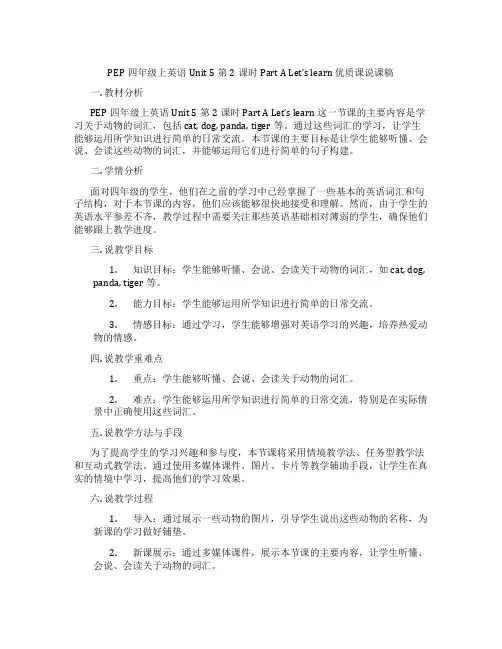
PEP四年级上英语Unit 5第2课时Part A Let’s learn 优质课说课稿一. 教材分析PEP四年级上英语Unit 5第2课时Part A Let’s learn 这一节课的主要内容是学习关于动物的词汇,包括cat, dog, panda, tiger等。
通过这些词汇的学习,让学生能够运用所学知识进行简单的日常交流。
本节课的主要目标是让学生能够听懂、会说、会读这些动物的词汇,并能够运用它们进行简单的句子构建。
二. 学情分析面对四年级的学生,他们在之前的学习中已经掌握了一些基本的英语词汇和句子结构,对于本节课的内容,他们应该能够很快地接受和理解。
然而,由于学生的英语水平参差不齐,教学过程中需要关注那些英语基础相对薄弱的学生,确保他们能够跟上教学进度。
三. 说教学目标1.知识目标:学生能够听懂、会说、会读关于动物的词汇,如cat, dog,panda, tiger等。
2.能力目标:学生能够运用所学知识进行简单的日常交流。
3.情感目标:通过学习,学生能够增强对英语学习的兴趣,培养热爱动物的情感。
四. 说教学重难点1.重点:学生能够听懂、会说、会读关于动物的词汇。
2.难点:学生能够运用所学知识进行简单的日常交流,特别是在实际情景中正确使用这些词汇。
五. 说教学方法与手段为了提高学生的学习兴趣和参与度,本节课将采用情境教学法、任务型教学法和互动式教学法。
通过使用多媒体课件、图片、卡片等教学辅助手段,让学生在真实的情境中学习,提高他们的学习效果。
六. 说教学过程1.导入:通过展示一些动物的图片,引导学生说出这些动物的名称,为新课的学习做好铺垫。
2.新课展示:通过多媒体课件,展示本节课的主要内容,让学生听懂、会说、会读关于动物的词汇。
3.课堂练习:通过小组活动,让学生在实际情景中运用所学知识进行交流,巩固所学内容。
4.课堂总结:对本节课的内容进行总结,让学生对所学知识有一个清晰的认识。
七. 说板书设计板书设计将简洁明了,主要包括本节课的主要词汇,如cat, dog, panda, tiger 等,以及一些关键的句子结构。
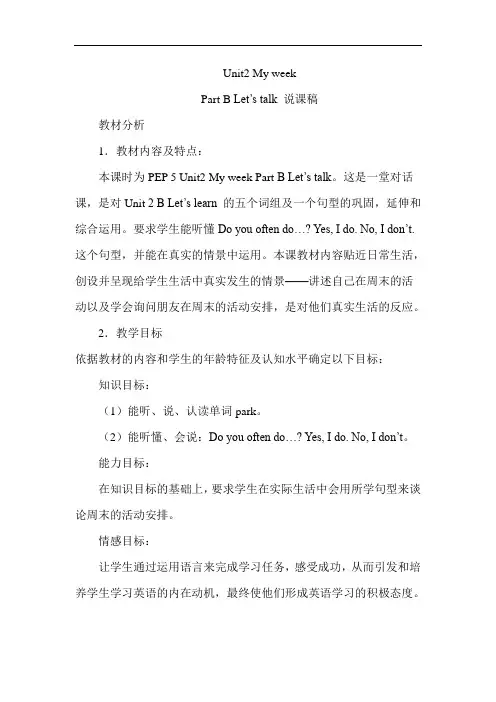
Unit2 My weekPart B Let’s talk 说课稿教材分析1.教材内容及特点:本课时为PEP 5 Unit2 My week Part B Let’s talk。
这是一堂对话课,是对Unit 2 B Let’s learn 的五个词组及一个句型的巩固,延伸和综合运用。
要求学生能听懂Do you often do…? Yes, I do. No, I don’t.这个句型,并能在真实的情景中运用。
本课教材内容贴近日常生活,创设并呈现给学生生活中真实发生的情景——讲述自己在周末的活动以及学会询问朋友在周末的活动安排,是对他们真实生活的反应。
2.教学目标依据教材的内容和学生的年龄特征及认知水平确定以下目标:知识目标:(1)能听、说、认读单词park。
(2)能听懂、会说:Do you often do…? Yes, I do. No, I don’t。
能力目标:在知识目标的基础上,要求学生在实际生活中会用所学句型来谈论周末的活动安排。
情感目标:让学生通过运用语言来完成学习任务,感受成功,从而引发和培养学生学习英语的内在动机,最终使他们形成英语学习的积极态度。
引导学生学会合理安排周末的活动,培养健康有益的兴趣爱好,养成良好的生活习惯。
3.教学重、难点(1)重点:掌握句型:Do you often do…? Yes, I do. No, I don’t (2)难点:学生能在真实的情景中灵活运用重点句型。
4.教具准备针对本课时的教学目标和教学重难点,我做了以下的教学准备:(1)配套的教学课件。
(2)学生采访活动记录表格。
二.说学情五年级的大多数学生好动、好胜、好新、好奇、思维活跃,对英语充满兴趣,但注意力持久性较差。
我在教学过程中注意创设情景和通过竞赛活动,给学生创设一个轻松愉快的语言学习氛围,让学习过程充满乐趣并同时使他们感受到一定的挑战,满足他们的竞争意识和成功感,从而使他们达到积极思维,创造潜能得以开发。
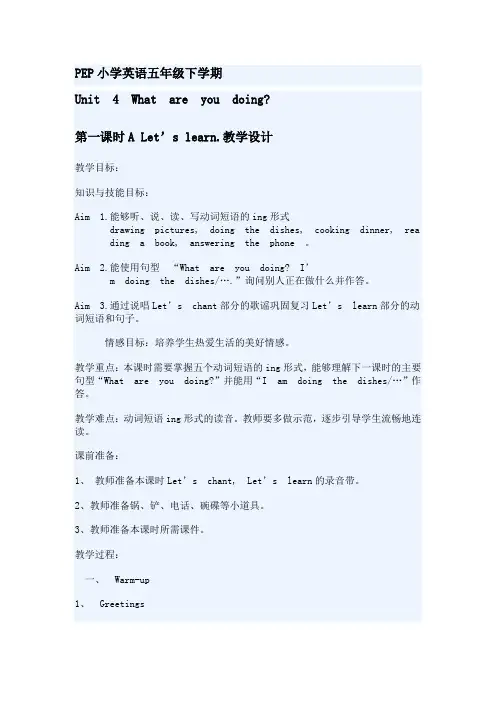
PEP小学英语五年级下学期Unit 4 What are you doing?第一课时A Let’s learn.教学设计教学目标:知识与技能目标:Aim 1.能够听、说、读、写动词短语的ing形式drawing pictures, doing the dishes, cooking dinner, reading a book, answering the phone 。
Aim 2.能使用句型“What are you doing? I’m doing the dishes/….”询问别人正在做什么并作答。
Aim 3.通过说唱Let’s chant部分的歌谣巩固复习Let’s learn部分的动词短语和句子。
情感目标:培养学生热爱生活的美好情感。
教学重点:本课时需要掌握五个动词短语的ing形式,能够理解下一课时的主要句型“What are you doing?”并能用“I am doing the dishes/…”作答。
教学难点:动词短语ing形式的读音。
教师要多做示范,逐步引导学生流畅地连读。
课前准备:1、教师准备本课时Let’s chant, Let’s learn的录音带。
2、教师准备锅、铲、电话、碗碟等小道具。
3、教师准备本课时所需课件。
教学过程:一、Warm-up1、Greetings2、Sing a song: I Can Help.(师生做动作共同演唱)Then ask the students:What phrase can you hear in this song ?(设计思路:通过师生边唱边做动作,既活跃了气氛,复习了相关家务劳动的短语,又为新课的学习做了铺垫。
)二、Review1、教师用课件出示五年级上册所学动词短语的图片,让学生认读,其他同学边跟读边做动作。
do the dishes cook the meals read a bookset the table do homework clean the room……2、Free talkI can do housework.What can you do?Can you cook the meals?Can you clean your bedroom?……三、Presentation1、教学doing the dishes,并表现现在实行时的问答形式:What are you doing? I am …。
![pep小学五年级英语上册Unit2第五课时说课稿[1]](https://uimg.taocdn.com/2ef9e884d4d8d15abe234efa.webp)
五年级英语Unit2 B let’stalk说课稿一、说教材1.教材内容本节课的主要内容是要求学生能用英语讲述自己在周末的活动以及学会询问朋友在周末的活动安排。
2. 教材的地位本节课的教学内容是学生真实生活的反映,学生学习之后,可以开展“了解朋友周末生活”为主题的调查活动。
这种活动能使学生在较真实的语境中锻炼语言交际能力,从而发展他们的语言思维能力,同时也能进一步培养学生之间的合作精神。
二、说目标1.教学目标依据教材的内容和学生的年龄特征及认知水平确定以下目标:知识目标:能听懂、会说: What do you do on Saturdays/Sundays? I often do homework, read books and watch TV. 并能在情景中加以运用。
能力目标:在知识目标的基础上,要求学生在实际生活中会用英语来谈论学习和生活,从而提高他们综合语言运用能力。
情感目标:让学生通过运用语言来完成学习任务,感受成功,从而引发和培养学生学习英语的内在动机,最终使他们形成英语学习的积极态度。
2.教学重、难点本课时的重点是掌握句型:What do you do on Saturdays/Sundays? I often do homework, read books and watch TV. 并能在真实情景中运用。
难点是正确运用新学的词组和句型谈论学习和生活实际。
三、说教法1. 教法设计本节课中,我针对儿童好动、好胜、好新、好奇、思维活跃,集中注意持久性较差等特点,在教学过程中注意创设各种游戏活动和竞赛活动,给学生创设一个轻松愉快的语言学习氛围,让学习过程充满乐趣并同时使他们感受到一定的挑战,满足他们的竞争意识和成功感,从而使他们达到积极思维,创造潜能得以开发。
另外,课中还让学生来代替教师的角色,真正实现师生角色的互换,缩短了师生的情感距离,以达到良好的教学效果。
2.这些方法的应用,能充分调动学生的各种感觉器官,激发学生积极参与课堂游戏活动。
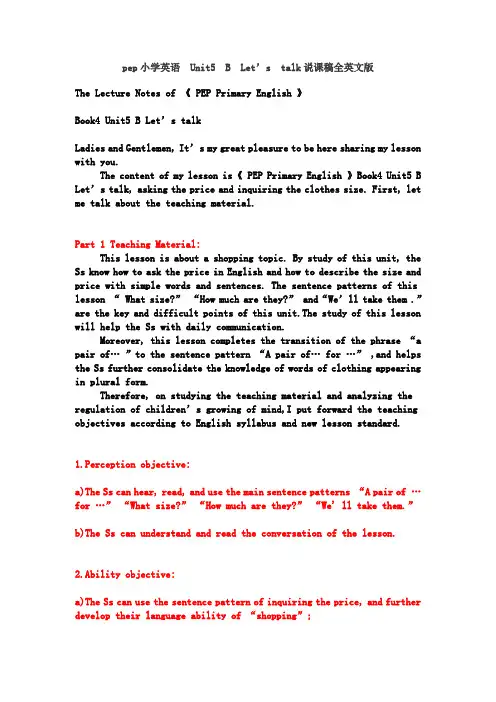
pep小学英语 Unit5 B Let’s talk说课稿全英文版The Lecture Notes of 《 PEP Primary English 》Book4 Unit5 B Let’s talkLadies and Gentlemen, It’s my great pleasure to be here sharing my lesson with you.The content of my lesson is《 PEP Primary English 》Book4 Unit5 B Let’s talk, asking the price and inquiring the clothes size. First, let me talk about the teaching material.Part 1 Teaching Material:This lesson is about a shopping topic. By study of this unit, the Ss know how to ask the price in English and how to describe the size and price with simple words and sentences. The sentence patterns of this lesson “ What size?”“How much are they?” and“We’ll take them .”are the key and difficult points of this unit.The study of this lesson will help the Ss with daily communication.Moreover, this lesson completes the transition of the phrase “a pair of…”to the sentence pattern “A pair of… for …” ,and helps the Ss further consolidate the knowledge of words of clothing appearing in plural form.Therefore, on studying the teaching material and analyzing the regulation of children’s growing of mind,I put forward the teaching objectives according to English syllabus and new lesson standard.1.Perception objective:a)The Ss can hear, read, and use the main sentence patterns “A pair of …for …”“What size?”“How much are they?”“We' ll take them.”b)The Ss can understand and read the conversation of the lesson.2.Ability objective:a)The Ss can use the sentence pattern of inquiring the price, and further develop their language ability of “shopping”;b)The Ss can use the patterns to express their thoughts in the proper scene.3.Emotion objective:a)By completing the task,the Ss increase their interest and set up self-confidence in language study;b)Teach the Ss what is “love” and “ managing money matters”, put the moral education in the language study.Next,the key points of this lesson:First of all, to study and use the sentence patterns “What size?”“How much are they ?”“A pair of … for … .”“We' ll take them.”To improve the Ss’ abilities in “shopping”;Secondly, teach the Ss how to study independently as well as by cooperation.Difficult points:The Ss can use the words and patterns to describe the clothes in the proper scene, and make simple dialogues of shopping.Well, how to achieve the teaching objectives better, to stress the key points and break through the difficult points? The key is how to make use of the proper teaching methods, I’ll talk about my teaching methods below.Part 2 Teaching Methods:According to the modern perception theories and social intercourse teaching theories, I adopt the TSA method and TBLT method in my teaching, namely Total Situational Action and Task-based Language Teaching.At the same time, make use of the modern electricity teaching equipments and all kinds of teaching means, it can mobilize the Ss’ enthusiasm and creativity in learning English.Part 3 Studying Methods:After feeling and comprehending the language points, let Ss obtain the knowledge actively by probe study and cooperative study. Thereby, develop the Ss’ abilities of studying and working with the learning language independently.Part 4 Teaching Process:Step1 Warm-up.Sing a song: The coat in window.So as to the psychological characteristics of children,singing a song can make Ss feel pleased and satisfied, and can arouse exciting motion. In this step , teacher and the Ss sing in unison and perform the song “The coat in window.” Thus,review the sentence pattern “How much is … ?” And arouse the Ss' performance desire, participation desire,and lead the Ss into a thick English studying atmosphere.Step2 Presentation and practice.1.Design: Look for Cinderella.Broadcast a part of “Cinderella” with the flash, presenting a crystal shoe that Cinderella lose, and establishes a scene of ministers look for the proper size everywhere. Through the role playing, guide the Ss to use the sentence pattern “What size do you wear?”“Size … .”to make the question and answer. This design is a novelty of my lesson; it leads the Ss into the fairy tales. They acquire the language unconsciously and can do communication freely.2.Lead to the shopping topic naturally from the unsuited shoes, and demonstrate the sentence pattern “How much are they?”With a good student to be the assistant, I perform to go shopping, and guide the Ss to make the answer: “They are … .”In this course, Ss can understand the main contents of this dialogue and get the key points by scene demonstration.3.Game:Guess the price.From buying a pair of shoes for myself to buying a pair for my mom, introduce the sentence pattern “A pair of … for … .”The CAI presents a big cabinet with various shoes, ask the Ss to guess their price, and then display them.It considers that children can keep their attentions in limited time. The game can avoid the lifelessness and boredom from the pure machine drills .It creates the conditions of a relaxed and natural atmosphere for children’s drills. Then achieve the aim of consolidating and deepening the sentence pattern.4.Present the text.a)At this time, John and his mom come to the shoe store.It reappears the relevant conversation by broadcasting the VCD, let Ss know the text contents with a combination of audio and video, words and pictures, which cater to the characteristics of primary period to be curious and pursuing interest andfreshness.b)After the audio-visual commences, play the tape recorder completely again, let the Ss concentrate on listening, then answer my questions according to the dialogue. e.g.:What size does John wear? How much? Whether buy or not, etc.c)After be familiar with the text, let the Ss try to act out the dialogue.By this step, it achieved the teaching aim of understanding and talking the dialogue of this lesson.Step3 Task time.Task:Mother’s Day.To master the language capability needs certain amount of practice.So,I still adopt the “Task-based”teaching method, which is defined by strongpracticality and exact task, so as to make break-through about the difficult points of this lesson.In advance, I shall arrange the classroom to some business locations, such as clothes store, shoes store, fruit store etc. I shall divide the class into groups and play roles, and then give the Ss a certain quantity of specie currency, so that they may choose and buy the gifts for Mother’s Day.For this step, I shall instruct the Ss to use the words and patterns learnt in the process of completing certain tasks. Meanwhile, they may have mutual improvement in exchanging information during the communicating activities.Most Ss can take their parts in the activities, especially for the Ss who have trouble in English study. In the group activities, they can speak a little English with ease. With no doubt, this will encourage them to speak English.In fact, it incarnates a kind of demand of human being.Suhuomulinsiji says:“In one’s mind, there is always a kind of deeply rooted demand, that is the hope to feel oneself a finder and explorer. In Ss’ spirits, such demand is specially strong.”This step also leads to the emotion objective of this lesson, that is to have moral education in this step.Step4 Consolidation and extension.Summarize the whole lesson,and arrange the homework.1.Do the correlative exercises in the activity book.Check the mastering of knowledge of this lesson.2.Ask Ss to interview their friends asking the price and size of their clothing and make records of the information.This content is an extension of the previous lesson, to meet the needs of increasing communicating demand of some Ss.Step5 Blackboard Design.Show on the CAI.(It’s a ….)Above is the lecture notes of my lesson. Thank you!。

小学英语学习材料金戈铁骑整理制作PEP五年级上册Unit2《My week》B Let’s talk 第一课时教学设计红旗中心校:任小静一、学情分析:本课的教学对象是小学五年级的学生,此段的学生在过去的两年学习中,有了一定的听、说、读、写和日常的语言交际能力,同时又有强烈的求知欲和好奇心,在本节课教学中,学生已经在本单元A部分已经掌握了“What do you have? I have...”等重点句型。
在课教堂学过程中,学生为学习的柱体,教师要为学生设计生动活泼的教学环节和轻松的学习氛围,充分调动学生的积极参与性,是学生能够敢于展示自我,做学习的主人。
二、教材分析本科内容选自PEP小学英语五年级上册,Unit2 Part B let’s talk,本单元主要围绕“What do you have on....?I have ....”等介绍学校课程及个人周末安排的表达法,通过学习,学生可向他人询问课程并表达自己,熟练运用句型“Do you often ....?Yes,I do/No,I don’t”,教育学生学会合理安排周末,做到劳逸结合,在学习过程中,进一步提高学生的语言交际能力,提高学生现实生活中获取信息能力。
三、教学目标教学内容1、教学内容:Part B Let’s try and Let’s talk2、能够正确听、说、读、写动词词组:play ping-pong ,play football do homework,listen to music。
3、能够正确听、说、朗读:“Do you often play ping-pong on theWeekend?”等句型询问别人经常做某事的句型。
4、在对话交流中使学生养成用英语交流的习惯,培养学生良好的语音、语调和语感。
四、教学重点难点分析重点:能够熟练运用本课重点句型“Do you often ...?”来询问他人经常做的事。
难点:1、句型:“Do you often ...?”的肯定和否定回答。
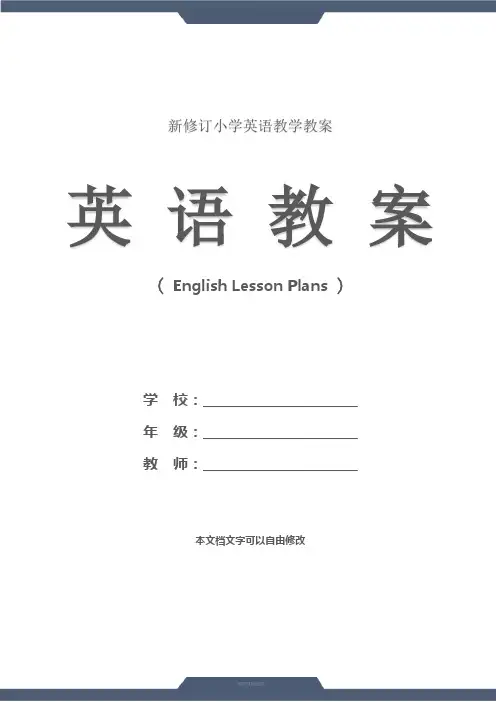
新修订小学英语教学教案英语教案( English Lesson Plans )学校:_______________________年级:_______________________教师:_______________________本文档文字可以自由修改五年级英语:PEP 5 Unit2 A Let’slearn(教学设计)教案初稿:pep book5 unit2 a let’s learn一、teaching aims1、能听懂、会说what day is it today? it’s…what do you have on…? we have…i like…并能在实际情景中应用。
2、培养学生热爱学习的美好情感。
二、important points掌握句型:what day is it today? it’s…what do you have on wednesdays? we have english, science, computer and p.e. .i like wednesdays.要求学能在实际情景中运用。
三、difficult points1、i like wednesdays中的“s”易读漏。
2、we have…句型较长,朗读较难流利。
四、teaching process.step proceduredesign noteswarm-up1、review words t:who can be little teacher?2、let’s chantmonday, monday, math on monday.tuesday, tuesday, art ontuesday.wednesday, wednesday,computers on wednesday.thursday, thursday, p.e. on thursday.friday, friday, my favorite day!复习前一课时的单词。
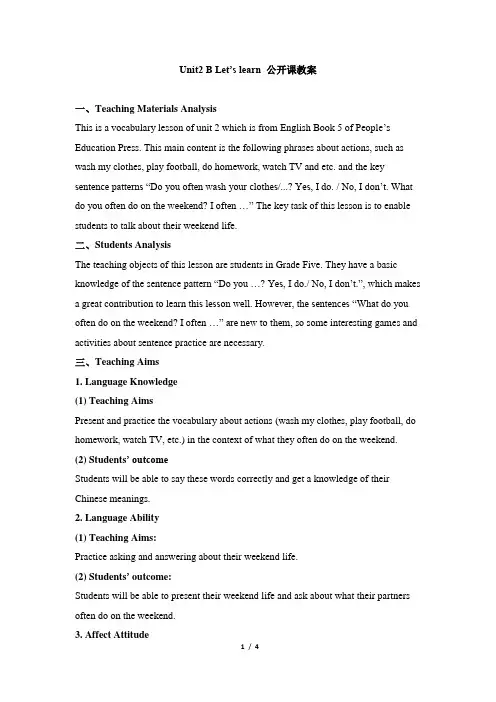
Unit2 B Let’s learn公开课教案一、Teaching Materials AnalysisThis is a vocabulary lesson of unit 2 which is from English Book 5 of People’s Education Press. This main content is the following phrases about actions, such as wash my clothes, play football, do homework, watch TV and etc. and the key sentence patterns “Do you often wash your clothes/...? Yes, I do. / No, I don’t. What do you often do on the weekend? I often …” The key task of this lesson is to enable students to talk about their weekend life.二、Students AnalysisThe teaching objects of this lesson are students in Grade Five. They have a basic knowledge of the sentence patte rn “Do you…? Yes, I do./ No, I don’t.”, which makes a great contribution to learn this lesson well. However, the sentences “What do you often do on the weekend? I often …” are new to them, so some interesting games and activities about sentence practice are necessary.三、Teaching Aims1. Language Knowledge(1) Teaching AimsPresent and practice the vocabulary about actions (wash my clothes, play football, do homework, watch TV, etc.) in the context of what they often do on the weekend. (2) Students’ outcomeStudents will be able to say these words correctly and get a knowledge of their Chinese meanings.2. Language Ability(1) Teaching Aims:Practice asking and answering about their weekend life.(2) Students’ outcome:Students will be able to present their weekend life and ask about what their partners often do on the weekend.3. Affect Attitude4. Teaching AimsEncourage students to arrange their weekend life reasonably and try to enrich their weekend life.(1) Students’ outcomeStudents will have the awareness of “A ll work and no play makes Jack a dull boy”.5. Learning Strategy:(1) Teaching Aims:Encourage students to cooperate with their partners to complete the learning task. (2) Students’ outcome:Students will have the awareness of cooperating with partners to complete the learning task.四、Teaching Key Points and Difficult Points1. Teaching Key PointsHave a good command of some vocabulary and sentence patterns about actions: wash my clothes, play football, do homework, watch TV and etc. “Do you often wash your clothes/...? Yes, I do. / No, I don’t. What do you often do on the weekend? I often …”2. Teaching Difficult PointsBe able to have a good communication with others about their weekend life with the learnt knowledge.五、Teaching AidsMulti-media; a tape-recorder; pictures; chalkboard, etc.六、教学过程Step 1 Warm-up (2 mins)T-SsSing the song “My week” after the tape.Intensions: Review the vocabulary about days in a relaxing atmosphere, which arouses their enthusiasm.Step 2 Lead-in (4 mins)T-SsS-SsAnswer the questions:Q1: How many days are there in a week?Q2: What are they?Q3: Which day do you like best? Why?Intensions: Guide students to express their own ideas through questions of different levels.Step 3 Presentation (16 mins)T-SsS-SsS-S1. Present the vocabulary with my video about my weekend lifeA: Watch the video and answer the questions.B: Read the vocabulary after the tape.Game TimeA: Let’s dance (Look at the phrases and do the actions)B: Look and say (Look at the actions/pictures and say the phrases)Intensions: Watching my video and guessing will arouse students’ curiosity. The challenge time can stimulate students’ interest in practicing the pronunciation of these words. Guide to watch TV in a correct way and cultivate them the awareness of helping at home.Step 4 Production (15 mins)T-SsS-Ss1. Pair work: Talk about their weekend.A: What do you often do on the weekend?B: I often …2. Group work: Work in groups of four and design a colourful weekend. Then choosea reporter to report.Intensions: Group work will help students learn to cooperate with others to complete the learning task and motivate their enthusiasm in the participation in consolidatingthe new words and sentence patterns. The mind-map will help students to arrange their weekend reasonably.Step 5 Summary (2 mins)T-SsMake a summary of the new words and the sentence pattern by raising questions. Step 6 Homework (1 min)T-SsRead after the tape.Design your dream weekend and write them down.。
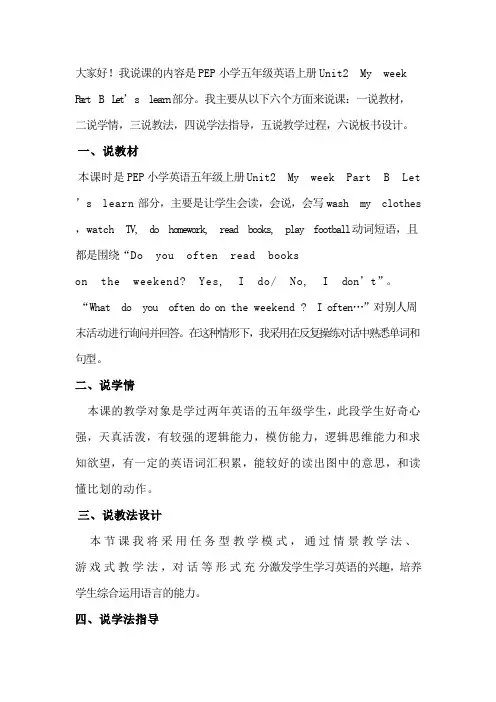
大家好!我说课的内容是PEP小学五年级英语上册Unit2 My weekP a r t B L e t’s l e a r n部分。
我主要从以下六个方面来说课:一说教材,二说学情,三说教法,四说学法指导,五说教学过程,六说板书设计。
一、说教材本课时是PEP小学英语五年级上册Unit2 My week Part B Let ’s learn部分,主要是让学生会读,会说,会写wash my clothes ,watch TV, do homework, read books, play football动词短语,且都是围绕“Do you often read bookson the weekend? Yes, I do/ No, I don’t”。
“What do you often do on the weekend ? I often…”对别人周末活动进行询问并回答。
在这种情形下,我采用在反复操练对话中熟悉单词和句型。
二、说学情本课的教学对象是学过两年英语的五年级学生,此段学生好奇心强,天真活泼,有较强的逻辑能力,模仿能力,逻辑思维能力和求知欲望,有一定的英语词汇积累,能较好的读出图中的意思,和读懂比划的动作。
三、说教法设计本节课我将采用任务型教学模式,通过情景教学法、游戏式教学法,对话等形式充分激发学生学习英语的兴趣,培养学生综合运用语言的能力。
四、说学法指导在本课中,我以课标为指导,以教读短语为主要活动方式,把短语运用到句中,同时在句子中练习短语的原则。
逐步提高学生的综合运用能力。
五、说教学过程Step1:Warm-up1、Greeting2、Listen and sing the song “Days of the week”.Monday, Tuesday, Wednesday, Thursday, Friday,Saturday,Sunday. Days for school and days for fun., Happy days for everyone.3、Free talkT:What day is it today? S:It’s ________.T: Do you go to school on Saturdays and Sundays? S:_________. T:What do you often do on the weekend? S: I often ….Step2: Presentation and practice(1) Students say some weekend activities.do homework, draw pictures, watch TV…(2) Present the weekend activitiesread books, play footall, play basketball…(3) Game. What’s missing?(4) Say the English phrases.(5) A:Do you often…..on the weekend?B:Yes,I do. /No,I don’t.Pair work and show(6) chant(7) Group workA:What do you often do on the weekend ?B: I often… , … and … on the weekend.C: I often… , … and … on the weekend.…Step3: ConsolidationLearn a sample article: My weekend.Write an article: My weekend.Step4: SummaryWhat do you learn in this class?Step5:Home work: copy the phrases. Write an article: My weekend.六、板书设计Unit 2 My weekwatch TV, do homework, read books,play football,wash my clothesDo you often … on the weekend?Yes, I do/ No, I don。
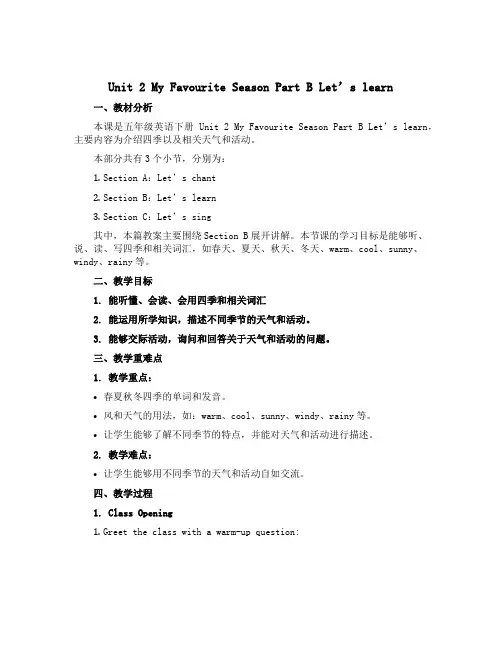
Unit 2 My Favourite Season Part B Let’s learn
一、教材分析
本课是五年级英语下册Unit 2 My Favourite Season Part B Let’s learn,主要内容为介绍四季以及相关天气和活动。
本部分共有3个小节,分别为:
1.Section A:Let’s chant
2.Section B:Let’s learn
3.Section C:Let’s sing
其中,本篇教案主要围绕Section B展开讲解。
本节课的学习目标是能够听、说、读、写四季和相关词汇,如春天、夏天、秋天、冬天、warm、cool、sunny、windy、rainy等。
二、教学目标
1. 能听懂、会读、会用四季和相关词汇
2. 能运用所学知识,描述不同季节的天气和活动。
3. 能够交际活动,询问和回答关于天气和活动的问题。
三、教学重难点
1. 教学重点:
•春夏秋冬四季的单词和发音。
•风和天气的用法,如:warm、cool、sunny、windy、rainy等。
•让学生能够了解不同季节的特点,并能对天气和活动进行描述。
2. 教学难点:
•让学生能够用不同季节的天气和活动自如交流。
四、教学过程
1. Class Opening
1.Greet the class with a warm-up question:。
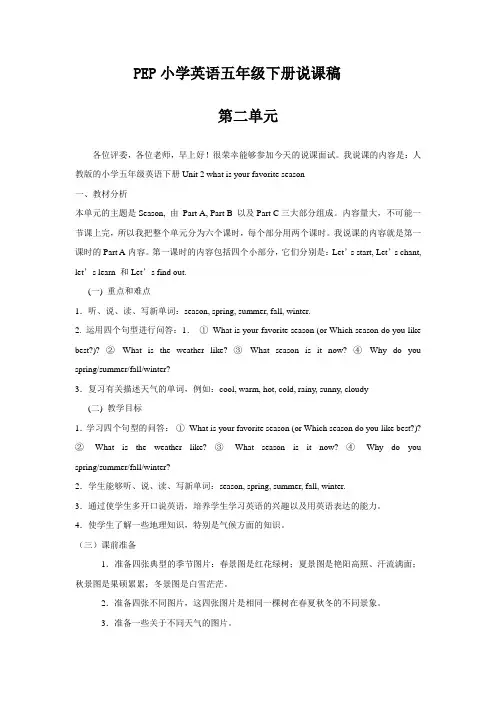
PEP小学英语五年级下册说课稿第二单元各位评委,各位老师,早上好!很荣幸能够参加今天的说课面试。
我说课的内容是:人教版的小学五年级英语下册Unit 2 what is your favorite season一、教材分析本单元的主题是Season, 由Part A, Part B 以及Part C三大部分组成。
内容量大,不可能一节课上完,所以我把整个单元分为六个课时,每个部分用两个课时。
我说课的内容就是第一课时的Part A内容。
第一课时的内容包括四个小部分,它们分别是:Let’s start, Let’s chant, let’s learn 和Let’s find out.(一) 重点和难点1.听、说、读、写新单词:season, spring, summer, fall, winter.2. 运用四个句型进行问答:1.①What is your favorite season (or Which season do you like best?)? ②What is the weather like? ③What season is it now? ④Why do you spring/summer/fall/winter?3.复习有关描述天气的单词,例如:cool, warm, hot, cold, rainy, sunny, cloudy(二) 教学目标1.学习四个句型的问答:①What is your favorite season (or Which season do you like best?)?②What is the weather like? ③What season is it now? ④Why do you spring/summer/fall/winter?2.学生能够听、说、读、写新单词:season, spring, summer, fall, winter.3.通过使学生多开口说英语,培养学生学习英语的兴趣以及用英语表达的能力。
PEP小学英语五年级下册Unit2Bletstalk全英说课稿Good afternoon, everyone. I’m Tracy, from Zhenhua Primary School . It’s my great honor to be here to present my lesson. The content of my lesson is PEP Primary English, Book6, Unit 2, My favourite season, Part B. Let’s talk.My teaching presentation includes 8 parts: analysis of the teaching material and the students, teaching aims, key points, difficult points, teaching aids, teaching methods, teaching procedure and blackboard design.Part 1: analysis of the teaching materialThe topic of the unit is “seasons”,based on the words learned and the activities held, this lesson aims to ensure that the students can make a dialogue on "my favorite seasons" and learn to state their reasons. The content of this unit is closely related to students' daily life, full of child interests, and most importantly, the students are very familiar with the words and structures, so it is good for their learning and communicationAnalysis of the studentsThe teaching object is students in Grade 5. They are lively, interested in games and competition. They have learned the words about seasons, like: spring, summer, fall, winter. In addition, they also learned many words or phrases as: swim, plant trees, fly kites, go hiking…Part 2: teaching aimsIn accordance with the students and the new standard curriculum, the teaching objectives are as follows:1.Aims on the knowledge(a) Ss are able to use the phrases ofv seasons and activitiesto communicate as follow:O What’s your favourite season?O Which season do you like best?O I like …O Why do you like…?O Because I can …2. Aims on the abilities.O Ss can read the target language fluently.O Ss can express their favourite season and state the reason correctly.O Ss can make a new dialogue by cooperation.3.Aims on the emotion.(a) Stimulate students' interest in learning English by using picture, animation and activities.(b) Students are able to love and cherish life, to love and protect nature.Part 3: Key pointThe Key point of this lesson is that the Ss can understand, read and speak the sentences as follow: What’s your favourite season? /Which season do you like best?/ I like …/ Why do you like…?/ Because I can …Part 4: difficult point:The difficult point is that Ss can communicate the target language correctly and fluently.Part 5: teaching aids:●Multi-media computer;●PPT;●word cards●related drawingsThey are used to help the Ss to grasp the key points andovercome the difficult points.Part 6: teaching methods:In this lesson, I will mainly use the game teaching method, direct teaching method, task-based teaching approach, situational teaching method and arrange some kind of class actives based on the “preparation, prese ntation, practice and production”.Part 7: teaching procedures:It includes 4 sections.Section One: Warming-upSing a song “What’s your favourite season?” together (2mins)It is important to form a better English learning surrounding for the Ss by singing Purpose of my design: To show the knowledge Ss have learned before, draw out the learning content with the song and stimulate the students’ study interest.Section two: Lead-in (1min )Show some pictures of the seasons and ask the students “What’s your favourite season?”Purpose of my design: To stimulate the interest and make good bedding for the revision and presentation.Section three: Presentation& Practice. It will take 25 mins.Step 1: show some pictures of spring. And I will say: I like spring. It’s warm. Then ask the students: What’s your favourite season?Then review the words of the weather: hot, warm ,sunny …Step 2: show some pictures of summer. And say: I like summer. I can wear my skirt. The ask the students: Which season do you like best?Then review the words of the clothes: pants, jeans, skirt, T-shirt…Purpose of my design: To lead to the new knowledge “What’s your favourite season?/ Which season do you like best? ”and review the old knowledge. Make a free environment for the students to talk.Step 3: Ask the students: How many seasons are there? Review the words of seasons according to a guessing game. And ask the students: Which season do you like best?What can you do in winter? Then review the words of activities.After that, I will say: I like spring because I can fly kites, climb mountains … Ss read the sentences after the teacher. and then ask the Ss why do you like …? Because I can … Let them state their reasons.Purpose of my design: Stimulate the Ss interests in learning English by playing games. Make a real situation for the students to talk freely.Step 4: Pair work (10min )Arrange the students into several groups to communicate with their partners. Purpose of my design: Ss are familiar with the dialogue by communication.Step 5: listen, answer the questions and have a role play (6mins)Ask Ss to listen to the tape and find out the answer and then read the dialogue after the tape. I will ask them to have a role play in groups and present in pairs.Purpose of my design: listening is the first step of the language acquisition, and role play can make them familiar with the dialogue.Section four: Extension. It will take 10mins.This section, I arrange 3 activitiesFirst, make a new dialogue.Purpose of my design: stimulate the Ss’ lear ning interests and help th em consolidate the phrases and sentences by arranging some activities.Second, fill in the blanks and talk with your partners with the pictures and key words. Purpose of my design: Task-based teaching method is used here to devel op the Ss’ abilities of communication and cooperation. When the Ss are carting out the tasks, they can acquire information, knowledge, and have their ability and skills trained.Third, enjoy the beautiful scenery about nature.Purpose of my design: Make the students to cherish life, love and protect nature. Thenenjoy a song to end the class.Section five: Homework(2 mins)1、Make a survey: Which seasons does your friend like? Why?2、Draw a picture of your favourite season. Write down what can you do in your favourite season.Purpose of my design: It is necessary for the Ss to do some extensive exercises after class to consolidate the knowledge they learned.Part 8: Blackboard designIn the middle of the blackboard, I will write down the topic and the key sentence patterns clearly.Unit 2 My Favourite SeasonPart B Let’talkWhat’s your favourite season?Which season do you like best?I like …Why do you like…?Because (I can) …Well, that’s all my teaching design. Thank you for your attention.。
Good morning, my dear judges. I am Huang Dan from Chengxiang Primary School.I’m glad to interpret my teaching design here. The teaching content is Part B Let’s talk, of Unit 2 My days of the week in PEP Primary English, Book 5 .Teaching position:Firstly, let’s focus on the teaching position.This lesson requires students to use English to talk about their weekend activities . In this unit,it plays a connecting link between the preceding and the following role.Teaching aims:I set the following aims.1. Knowledge aims:(1)To enable the students to understand and say :What do you do on Saturdays/Sundays? I often do homework,watch TV and read books.Make sure that students can use these sentences in real situation.(2) To help students to finish the survey.(3) Have students listen and finish “Let’s try”2. Ability aim:Talking about their weekend activities with the new sentences3. Emotion aim:To foster students arrange their weekend activities reasonableTeaching focus:To enable the students to master the sentences:What do you do on Saturdays/Sundays? I often do homework,watch TV and read books.Make sure that students can use these sentences in real situation.Teaching difficulty:Using the new sentences to disscuss their study and life in real situation. Teaching methods:In this lesson,I will mainly use “Task-based teaching method”and“Situational teaching method.”That is to say, I will have the students learn in real situations, finish a task by making a survey to help the students to get a better understanding of the key structure of the dialogue. I will arrange 3 kinds of activities: guessing game, finishing a survey and having a competition.Learning methods:The learning methods are group cooperation approach and communicative approach.Teaching aids:And in this lesson PPT, some cards of phrases and a printed form will be needed.Teaching steps:Next, let’s focus on the teaching steps.I will finish the lesson in 3 steps.Step 1. Warm-up and lead in(1) After greeting with the students,I take out some cards of phrases: do homework,watch TV,read books,play football, do sports. Ask a student to come to the front in each group, then get a card from teacher’s hand, look at the phrase and do the action.The others say the phrase in English at the same time.(2) Have students listen and finish “Let’s try”[Purpose:The purose is through the game, to stimulate students interest in learning. It also pave the way for the next step in learning.]Step 2. Presentation and practiseNow I’ll mainly talk about this step.1.Play the PPT.Show some pictures about my week activities.Have the students look ,listen and answer my questions..【Listening contents:Hi! I’m Miss Huang, I like apples .I often read books on Saturdays. I often watch TV and do sports on Sundays .What about you? 】I ask: What do I do on Saturdays? What do I do on Sundays? Let students answer. Then I asked one of the students:What do you do on Saturdays?let him answer.2.After that ,get the students to read the following sentences.Make sure they can say it correctly.What do you do on Saturdays?What do you do on Sundays?I often……..3.Then have the students ask, individual students answer.4.Next,I divide students into groups of four. Have the students play a game. This game is as follows: group members ask one together:" What do you do on Saturdays?", he answers: " I often do homework ". Group members continue to ask next man, he answers such as" I often do homework and watch TV.", followed by analogy.By the end of the game ,get two groups of students to show their dialogue. 5.Let’s talkPlay the PPT.Have the students listen and repeat the dialogue.Pay attention to their pronunciation and intonation.[Purpose:PPT can provides a real situation for the students to understand the dialogue .Task-based teaching method and Situational teaching method are used here to develop students’ ability of communication and cooperation.]Step 3 Consolidation and extension1.Each one would finish the printed form by asking and answering: What do you do on Saturdays/Sundays?They can ask who he wants to ask as much as possible.In 5 minutes,find out the winner.2.Get the students to design their weekend activities .Then disscuss in groups of four.[Purpose:The two activities test the students to master the new and foster students arrange their weekend activities reasonable.]Step4 Homework1.Draw some pictures about your weekend activities.2.Make a time table about your weekend.【The purpose is to e nhance students’ use of English sense】Blackboard design:My blackboard design like thisI write the topic on the first line.The dialogue of “Let’s talk” is under the topic.That’s all for my teaching design. Thank you for listening.。
人教版五年级英语说课稿Unit 2 Part B
说课稿
Unit2MyDaysoftheWeek(B-2)
一.说教材
本课内容是PEP第五册Unit2B部分的Let’stalk部分.本课的设计思路是通过呈现、操练、小组活动和延伸等环节,让学生充分掌握本课知识,熟练运用。
教学目标是学生能听懂、会说:
WhatdoyoudoonSaturdays/Sundays?Ioftendohomework,readbooksandwatchTV.并学会运用。
教学重点难点是句型:Whatdoyoudoon…?Ioften….要求学生能在真实情景中运用。
二.说教法
新课程强调从学生的学习兴趣、生活经验和认识水平出发,倡导体验、实践、参与、合作与交流的学习方式和任务型的教学途径达到发展学生对语言的综合运用能力。
为了到达教学目标,落实教学重点、化解教学难点,本堂课借助flash,丰富了课堂教学形式;借助一些小奖品,如福娃的sticker……。
2014年辽宁教师考试小学英语说课稿:《PEP5 Unit2 B Let’s talk/Pair work》说课稿相关推荐:教师招聘考试题库辽宁教师招聘公告信息1. 说教材1.1 教材内容本节课的主要内容是要求学生能讲述自己在周末的活动以及学会询问朋友在周末的活动安排。
1.2 教材的地位《英语课程标准》中把“激发和培养学生学习英语的兴趣”放在英语教学的首位,在小学英语启蒙教学中教师尤其要关注这一点。
那么如何使学生对英语的学习具有情趣性呢?最关键的一点就是学习内容应该和学生的生活实际息息相关,尽可能地贴近他们的生活。
本节课的教学内容是学生真实生活的反映,学生学习之后,可以开展“了解朋友周末生活”为主题的调查活动。
这种活动能使学生在较真实的语境中锻炼语言交际能力,从而发展他们的语言思维能力,同时也能进一步培养学生之间的合作精神。
2. 说目标2.1 教学目标依据教材的内容和学生的年龄特征及认知水平确定以下目标:知识目标:能听懂、会说: What do you do on Saturdays/Sundays? I often do homework, read books and watch TV. 并能在情景中加以运用。
能力目标:在知识目标的基础上,要求学生在实际生活中会用英语来谈论学习和生活,从而提高他们综合语言运用能力。
情感目标:让学生通过运用语言来完成学习任务,感受成功,从而引发和培养学生学习英语的内在动机,最终使他们形成英语学习的积极态度。
2.2 教学重、难点本课时的重点是掌握句型:What do you do on Saturdays/Sundays?I often do homework, read books and watch TV. 并能在真实情景中运用。
3. 说教法3.1 教法设计课堂教学过程中要始终把学生放在教学的主体,学生通过教师的适时引导、启发和点拨来完成学习活动,从而建构起自己新的知识结构体系,最终实现教学与学的最佳结合。
本节课中,针对儿童好动、好胜、好新、好奇、思维活跃,集中注意持久性较差等特点,在教学过程中注意创设各种游戏活动和竞赛活动,给学生创设一个轻松愉快的语言学习氛围,让学习过程充满乐趣并同时使他们感受到一定的挑战,满足他们的竞争意识和成功感,从而使他们达到积极思维,创造潜能得以开发。
另外,课中还让学生来代替教师的角色,真正实现师生角色的互换,缩短了师生的情感距离,以达到良好的教学效果。
3.2 在学法指导上,重视多元智能教学理论、合作学习法和任务型语言学习法等应用。
这些方法的应用,能充分调动学生的各种感觉器官,激发学生积极参与课堂游戏活动。
通过这些活动不仅能培养学生大胆表达的良好学习习惯,而且还为学生提供充分的语言实践机会。
如本节课中的任务型教学活动,学习的空间更加开放,能激发学生创造性地使用所学语言,从而使学生的思维得以激活,学生自主学习的能力得以发展。
3.3 教学手段根据本节课的内容特点和学校设备的情况,我采用了自制教学卡片和自制录音磁带的教学手段,使用方便,易于操作,较实用。
自制卡片在本节课中的使用方法与学生现实生活中课余时间玩的一些娱乐活动方法相类似,从而使学生的情感世界与课堂娱乐活动产生共鸣,有利于教学难点的突破。
另外,一套自制卡片可以在课堂上反复使用,能使更多的学生参与到课堂活动中来,增大了学生课堂参与的面,有利于全面提高教学质量。
4. 说过程4.1 导入设计4.1.1 播放歌谣,营造气氛课一开始,教师播放Part B Let’s chant这首歌谣,让学生再次感受这首歌谣的节奏和韵律,为新句型的教学作好铺垫。
4.1.2 “心有灵犀”活动,激发兴趣,引发思考教师事先将Part B Let’s learn 中的词组和以前说过的词组写在纸条上,词组如下:do homework, watch TV, read books, play football, water the flowers, do housework etc. 然后每小组抽两名学生到到黑板前来,一名学生抽其中的一张纸条,看纸条后将词组用动作表示出来,另一名学生用英语来描述此动作。
4.1.3 再次感受,强化记忆全班学生以抢答的形式,再次巩固和强化上节课的内容。
抢答的方法如下:教师将以上的词组的图片贴在黑板上(图片上只是图,没有文字提示),教师报其中的图片号码,全体学生抢答。
设计意图:通过抢答游戏,让全体学生动起来,避免了机械单调地读,活跃了课堂气氛,激发了学生学习的兴趣,同时也锻炼了学生观察、记忆和快速反应的能力。
4.2 新课呈现4.2.1 听力先行,感知新语言在复习以上词组的基础上,教师布置一个任务,让学生来听一听以上所有的活动中,教师平时在星期天常做的是哪一件事?设计意图:教师将自己事先录制好的一段有关自己星期天常做的那件事的英语短文放给学生听。
这样一方面有利于拉近师生之间的关系,另一方面听力练习可以用来帮助学生在进入Let’s talk 新句型的学习之前先从听觉上感知新语言点。
4.2.2 创设生活情景,自由练说教师创设“看看谁的好朋友最多?”游戏。
活动可以如下进行:教师承接上面听力中自己最常的那件事,如:water the flowers,于是就说:“I often water the flowers.”。
如有学生在星期天与教师做的事一样,就马上站起来说:“I often water the flowers, too.”。
然后教师逐一抽学生模仿老师一样用“I often….”来完成,学生也可以同时选择一个以上的动作,以增加活动的刺激性。
在活动中,教师只要将每次站起来的人数统计好,到活动最后评出好朋友最多的那位学生。
设计意图:这样的一个活动,把学生带入了真实生活的情境,为练说新句型作好了情感铺垫。
又根据学生的特点,抓住他们喜欢交友、喜欢热闹之情,挖掘学生的认知和情感,自然地引出新句型“I often….”。
4.2.3 游戏活动,引出句型,突破难点教师准备好两个抽奖箱,箱子里事先放好一些学生已学过的动词词组纸条,然后同桌两人同时上去,分别在两个箱子里抽一张。
下面的学生先观察教师手中的时间标牌,如Sundays, Saturdays, Fridays….后齐声问上面的两个学生:“What do you do on Saturdays?”。
上面的两个学生依次根据自己手中的纸条回答:“I often….”如果两个学生抽到的纸条内容一致,就可以为他们这一组得2分,最后看哪一组得到的分数多。
设计意图:通过这个游戏,可以自然地引出句型:“What do you do on Saturdays?”,并能有的放矢地先引导全体学生初步学会询问。
新课标指出,学生师学习的主体,不应以教师不断的带读来代替学生自己的感悟与实践,而应让学生通过游戏活动自己来理解感受,最终自然习得。
4.3 操练巩固4.3.1 歌曲融入句型,关注孩子情感教师将上一步用过的纸条任意在教室内走动,嘴里同时唱着:“What do you do on Saturdays?”,然后突然将纸条出示给一个同学,那位同学必须运用所给的词组快速唱出:“I often read books/play football….”。
谁能接上,就由他来代替教师的角色。
设计意图:此活动加深对所学句型的印象,放松学生情绪,在优美的歌曲中快速巩固句型,体现无意识学习。
另一方面这种游戏有利于教师进行情感沟通,以达到师生愉快合作,共同完成学习任务的目的。
4.3.2 分组活动,及时巩固教师将全班以四人或六人为小组分开,然后以小组为单位进行接龙游戏。
活动如下:小组成员先集体提问其中的一人:“What do you do on Saturdays?”,由他回答:“I often read books.”。
小组成员继续集体提问下一人,他必须在原有答案的基础上在增加内容,如“I often read books and play football.”,这样依次类推。
设计意图:在大班制教学环境下,单向式的师生问答是很难使全体学生在课堂上都真正“动”起来的。
因此,通过这样的分组活动,可以让每个学生都有机会在参与游戏中巩固这个句型,有利于为不同层次的学生提供有利的学习条件,同时学生的合作精神和协调能力也能得到培养和发展。
4.3.3 布置任务,发展能力教师将全班一分为二,先让其中的一半学生每人手拿类似Pair work部分的表格,到另一半学生去作调查,然后交换。
调查时,教师务必要规定时间,时间一到要求调查学生全部回到座位。
调查的学生必须要用句型:“Saturday, Sunday, What do you do on the weekend?”,最后看哪个学生在规定的时间内完成调查的人数最多,他就被称为“最佳调查员”。
设计意图:这是一项集交际、任务、评价等目标于一体的综合性语言活动。
学生通过实践、参与等途径,在学习过程中能将外部的操作活动和内部的语言思维活动相结合起来,形成一个学生主体自己操作、自己体验、自己感悟的过程,最终发展学生的综合语言运用能力。
4.4 拓展延伸4.4.1 设计周末一天的安排要求学生以表格形式填好活动内容与时间,然后在班中或小组内交流。
如I often get up at 7:30. I often have breakfast at 8:00. I often read books at 8;00. I often do sports at 9:00, etc.设计意图:课标明确规定:教学要重视从学生的日常生活出发,培养学生实际运用语言的能力。
因此,让学生结合生活实际来设计自己周末一天的生活安排,能使学生切实感到身边有英语,从而增强学生运用英语的意识,培养学生的自主创新能力。
4.5 课后作业(1)开展“小小设计师”活动,让学生设计更多的周末活动,以图画的形式画出来。
(2)以本节课的主要句型编一首chant。
5. 说评价英语教学应提倡“学中用,用中学,学用结合,学以致用”。
在教学过程中,学和用是一个整体。
这节课中,为实现教学目标,我所设计的每一个教学游戏活动始终将学生置于一种自主、和谐、轻松的自然学习氛围中,从而使学生在不断地习得和使用语言中将语言知识内化,为学生自我求知、自我获取知识创造了有利条件,促进了学生思维的活跃和才能的发挥。
2014辽宁教师招聘考试公告汇总/html/2014/ggxx_0806/10526.html。